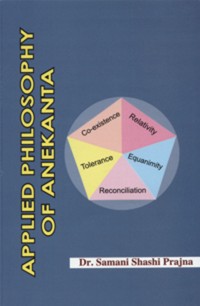It can be observed here that the history of the development of the anekāntavāda passed through four periods.
The first period is the period of canonical literature, wherein we studied naya as the basis of anekānta and how anekāntavāda in vibhajyavāda method is explored both by Mahāvīra and Lord Buddha. But Mahāvīra is asserted as the propounder of anekānta, because he used this method of anekānta in every dialogue, for attaining non-absolutist solutions to all the then current problems existing at that point of time.
The second period is dominated by Siddhasena, Samantabhadra and Mallavādin. The main current of this period was not the systematization of logical notions, but against the attack of absolutistic systems. The theories of anekānta and naya with their perspective of identity-cum-difference were defended with other systems, is the principle topic of discussion of this age.
The third period begins with Akalamka and lasts up to Vadidevasuri. It was necessitated by the attacks of Dignāga and Dharmakīrti on the traditional notions of the sources of anekānta. All the systems were arranged logically just to reply the non-Jaina debate attacks. Hemachandra was the last philosopher, who contributed to this period by reconciling the prevailing non-Jaina school of thoughts through the weapon of anekānta philosophy. After him, we can say that from the 12th century to15 century, the Jaina philosophical world of literature had a dark period in the history of logical world in Jainism.
The fourth period is the contribution of Upādhyāya Yaśovijaya (17th cent. CE). He interpreted the Jaina logic and philosophy in the Navyanyāya style and made it up to date. After him as far as my research goes, for two centuries (18th and 19th century) nobody seriously reflected on the theory of anekāntavāda and added something new in the world of philosophy. But from the 20th century again the new dimension, new paradigm shift took place in the world of philosophy. Many scholars started having misconception that anekānta and syādvād is the theory of probabilism, maybeism, scepticism and so forth. Moreover it is claimed that anekānta is merely a combination of all the heretic alien views and has nothing new to contribute of its own as found in the writings of Surendra Das Gupta, Padbanabh Jaini, Satkari Mukherjee and so forth. In the 20th century, two great thinkers of the age, Ācārya Tulsi and Ācārya Mahaprajña again came with the deeper philosophical and pragmatic understanding of anekānta.
A series of books were written by them in a new style of interpretation of anekānta. Moreover questions raised by the scholars who were having ambiguity and inconsistency regarding the concept of anekānta, are resolved by them in a logical way. In the modern period in the world of research, the two works were presented in a book form on Jaina Darshan Mein Anekantavada by Ashok Kumar Jain and Manju Nahata with the specific topic of 'Anekantavada through Paintings'. In the former work philosophical aspect of anekānta is dealt with and in the latter work, abstract concept of anekānta is expressed in a concrete way by means of skilful art and paintings. Along with this, seminars and conferences held on the topic of anekāntavāda in different places of India and abroad, the edited articles presented by the scholars in the respective seminars were compiled and published in the book form namely, 'Multi-Dimensional Application of Anekāntavāda’, 'Ahimsa, Anekānta and Jainism', ‘Facets of Jain Philosophy, Religion and Culture: Anekāntavāda and Syādvāda’. All the four books, do touch upon more about the theoretical and very less about the practical aspect of anekāntavāda. So an independent endeavour has been made by me to present the applied philosophy of anekānta. After the brief discussion of origin and development of anekānta we will proceed further to have a brief introduction to metaphysical basis of anekānta.
 Dr. Samani Shashi Pragya
Dr. Samani Shashi Pragya

